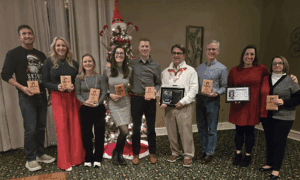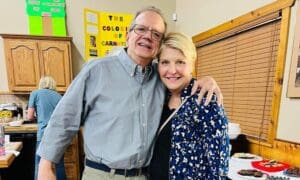A new group of architecture students from Georgia Tech who are plotting the potential future of Peachtree City’s village retail centers got invaluable feedback during a strategy session Wednesday afternoon.
Bill Hooper of Peachtree Crossing in Glenloch Village, John Sebring of Braelinn Village and Gordon Fleming of the Aberdeen Village shopping center joined current and former city officials in providing direction for the students as they proceed with the refinement of the initial designs presented last fall.
With the exception of Elizabeth Morris, who has interned with the city planning department, the other four students on the project are brand new and were anxious to get input on the direction they should take.
The students have already paid visits to Peachtree City and tootled around on golf carts to get a feel for the area. But the input from the shopping center representatives is crucial since they ultimately control the future destinies of those properties.
The first round of designs included some significant greenspace improvements for many of the shopping centers. One of the designs for the Glenloch center included a significant open park area along Ga. Highway 54 that was envisioned as a passive park and gathering place for community events such as an art show.
Hooper said he’d prefer to change the scale of the greenspace by adding bits and pieces perhaps 10-20 feet wide such as gardens.
Morris said the rationale for the large greenspace was to help draw residents to the shopping center even without the presence of a large anchor store. Peachtree Crossing last year lost the “Baby Kroger” grocery store, which has remained vacant since.
Morris noted that with four other large grocery stores in the area, the likelihood of attracting another grocer may not be feasible. Hooper said it could be feasible to have one, two or perhaps three tenants sharing the space, but it was premature to make that determination.
Joel Cowan, the city’s first mayor and long considered one of the city fathers, said he would like to see the city legally restrict the amount of impervious surface allowed in shopping centers. Tree and landscape buffers along the road from parking lot views of “bumpers and chrome,” Cowan added.
Another facet of the designs for Peachtree Crossing included improved golf cart connectivity, Morris said. In addition to making the on-site improvements, the students planned new cart path connections a short distance away on the path system to make the routes more direct.
Mayor Don Haddix said the major problem with the new connections would be funding.
Hooper said any changes to the center would have to be economically feasible, and he contended that despite the loss of the “Baby Kroger” store the center is holding its own with locally owned tenants, many of whom have been there for a number of years.
“Those owners have seen something valuable to them in what is a relatively mundane old-style looking shopping center,” Hooper said. “We don’t want to throw the baby out with the bathwater. … To move things in a dramatic way may not be the way to go.”
Hopper suggested a dramatic notion of his own: that the area could be developed vertically as well to take advantage of views from above including those of the adjacent Flat Creek golf course.
Longtime resident Gordon Fleming, a part-owner of the Aberdeen shopping center, said a re-freshening of the city shopping centers could be a great idea. Fleming said he will be excited to see the various options for the future that the students will provide.
There was some talk of changing the city’s sign regulations to allow “tasteful” directional signage. But Fleming cautioned against going in that direction.
“It’s absolutely wonderful to come through Peachtree City without the signs,” Fleming said, noting that many residents can tell you what stores are in each shopping center.
Fleming also admitted that in the 1960s and 70s he was opposed to the then novel-idea of using golf carts to get around the city.
“I was totally against it. … I thought it was the dumbest thing in my life.”
Not only does Fleming admit his mistake, but he is reminded of it daily as he witnesses joggers, walkers and carts along the path system which weaves through more than 80 miles of the city.
While all this talk is aimed at the future, Braelinn Village is in the middle of a significant construction project that will result in a new exterior, redesigned parking and more areas for lingering such as benches and the like. Sebring, who manages the center for The Shopping Center Group, said he wants the facility to “cater to the golf carts.”
As part of that, Braelinn Village will be improving the aesthetics of the golf carts’ entryway to the shops, which runs behind the stores. The center is also adding golf cart charging stations in an effort to attract more golf cart traffic.
Part of the idea is to provide service to the community but a crucial factor is attracting “mom and pop” retail stores, Sebring said.
Mark Hollums of the Peachtree City Development Authority said the dollars spent at mom and pop stores tend to recirculate in the local economy for a longer period of time than those spent at a chain store.
Hollums noted that small retailers also face challenges from large chains such as Walmart who can provide lower prices due to buying power
Hollums said the challenges for the city’s future extend beyond the shopping centers and into the industrial park, as the city has lost a number of manufacturing jobs. He said he would like to see the industrial park reconfigured to provide jobs for people who live in the city who currently have to commute into Atlanta for work.
The planning effort is being funded by the Peachtree City Development Authority.











Leave a Comment
You must be logged in to post a comment.